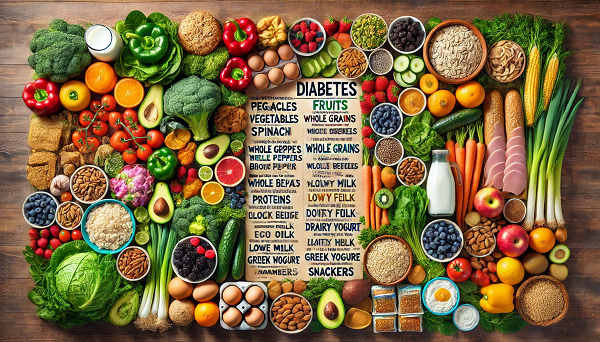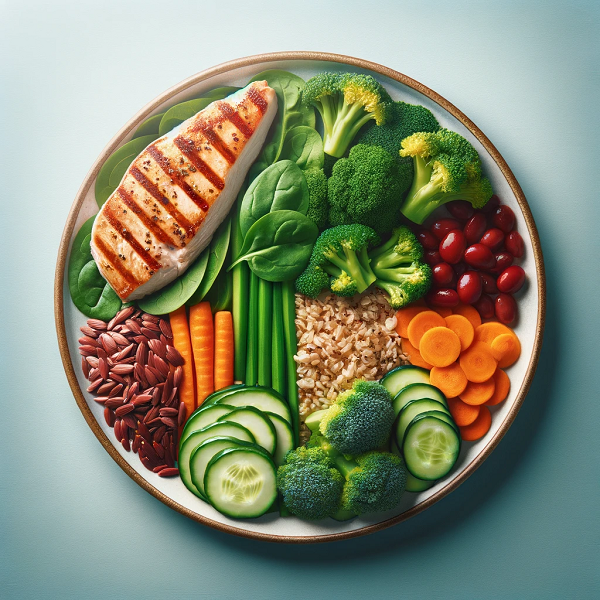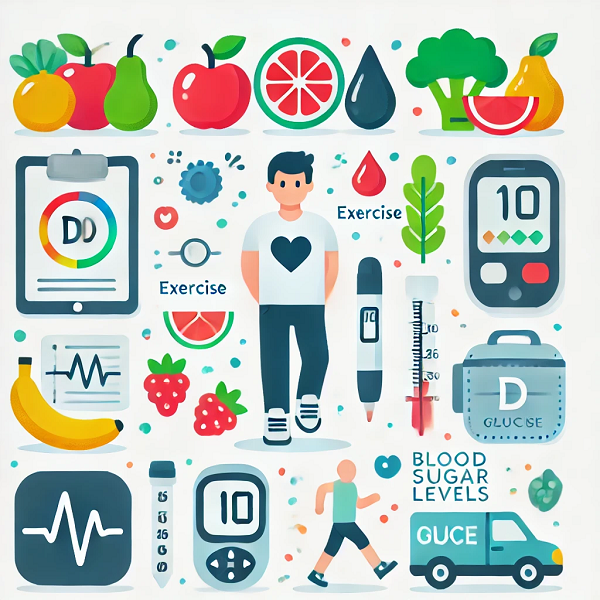Creating a diabetes-friendly grocery list is essential for managing blood sugar levels and maintaining overall health. This guide will help you choose foods that support a balanced diet, control blood sugar spikes, and provide the necessary nutrients for a healthy lifestyle. By planning ahead and making informed choices, you can navigate the grocery store with confidence and make every meal a step toward better health.
Understanding Diabetes and Nutrition
Before diving into the specifics of a grocery list, it’s crucial to understand the relationship between diabetes and nutrition. Diabetes is a chronic condition that affects how your body processes blood glucose, commonly known as blood sugar. Blood glucose is the primary source of energy for your body’s cells, and it comes mainly from the food you eat. Insulin, a hormone produced by the pancreas, helps glucose from food get into your cells to be used for energy.
In people with diabetes, this process is impaired. Either the body does not produce enough insulin, the cells do not respond properly to insulin, or both. This leads to elevated levels of glucose in the blood, which can cause a range of health issues over time if not properly managed.
Importance of Stable Blood Sugar Levels
The primary goal for people with diabetes is to maintain stable blood sugar levels. Fluctuations in blood sugar can lead to immediate problems such as hyperglycemia (high blood sugar) or hypoglycemia (low blood sugar). Over time, consistently high blood sugar levels can result in serious complications including heart disease, nerve damage, kidney failure, and vision problems. On the other hand, low blood sugar levels can cause symptoms like dizziness, confusion, and even loss of consciousness.
Role of Nutrition
One of the key ways to achieve stable blood sugar levels is through proper nutrition. The food you eat has a direct impact on your blood glucose levels. Carbohydrates, proteins, and fats all affect blood sugar differently:
- Carbohydrates are broken down into glucose and have the most immediate impact on blood sugar levels. Therefore, managing carbohydrate intake is crucial for diabetes management. It’s important to focus on complex carbohydrates, such as whole grains, which are absorbed more slowly and cause a gradual rise in blood sugar.
- Proteins have a minimal impact on blood sugar levels but are essential for maintaining muscle mass and overall health. Including a source of protein in every meal can help balance blood sugar levels.
- Fats do not directly raise blood sugar levels but are important for heart health. Choosing healthy fats, such as those found in nuts, seeds, and avocados, can support overall well-being.
Comprehensive Diabetes Management
While diet is a cornerstone of diabetes management, it is most effective when combined with other strategies. Medication, whether oral or injectable, helps control blood sugar levels and must be taken as prescribed. Physical activity also plays a significant role in managing diabetes. Exercise helps lower blood sugar levels by increasing insulin sensitivity and allowing your muscles to use glucose more effectively.
In summary, maintaining stable blood sugar levels requires a comprehensive approach that includes medication, physical activity, and a carefully planned diet. Understanding how different foods affect your blood sugar is essential for making informed choices that support your health. By creating a diabetes-friendly grocery list, you can take a proactive step towards better diabetes management and overall wellness.
Understanding the different types of diabetes is essential for managing the condition effectively. Each type has unique characteristics and requires specific management strategies, although a healthy diet is a common denominator in all cases.
Type 1 Diabetes
Type 1 diabetes is an autoimmune condition where the body’s immune system mistakenly attacks and destroys the insulin-producing beta cells in the pancreas. As a result, the body is unable to produce insulin, a hormone that regulates blood glucose levels by facilitating the uptake of glucose into cells for energy.
This type of diabetes typically appears in childhood or adolescence, but it can develop at any age. Symptoms of type 1 diabetes include increased thirst, frequent urination, unexplained weight loss, extreme hunger, and fatigue. Managing type 1 diabetes involves daily insulin injections or the use of an insulin pump, regular blood sugar monitoring, and a carefully planned diet to keep blood sugar levels within a target range.
Type 2 Diabetes
Type 2 diabetes is the most common form of diabetes and is often associated with older age, obesity, family history, physical inactivity, and certain ethnic backgrounds. Unlike type 1 diabetes, where the body does not produce insulin, type 2 diabetes occurs when the body becomes resistant to insulin or does not produce enough insulin to maintain normal blood glucose levels.
In type 2 diabetes, the cells in the body do not respond effectively to insulin, leading to higher blood glucose levels. Symptoms may develop slowly and can include increased thirst, frequent urination, blurred vision, slow-healing sores, and frequent infections. Management strategies for type 2 diabetes include lifestyle changes such as adopting a healthy diet, increasing physical activity, losing weight if necessary, and medications that help control blood sugar levels. In some cases, insulin therapy may also be required.
Gestational Diabetes
Gestational diabetes develops during pregnancy and usually disappears after giving birth. This condition occurs when the body cannot produce enough insulin to meet the increased demands during pregnancy, leading to elevated blood glucose levels. Gestational diabetes can increase the risk of complications for both the mother and the baby, including high birth weight, premature birth, and the development of type 2 diabetes later in life.
Women with gestational diabetes need to monitor their blood sugar levels regularly, follow a healthy eating plan, engage in regular physical activity, and sometimes take insulin or other medications to manage their blood glucose levels. It is essential to work closely with a healthcare provider to ensure a healthy pregnancy and reduce the risk of complications.
Management Strategies for Different Types of Diabetes
While each type of diabetes requires specific management strategies, some common principles apply to all. A healthy diet is crucial for managing blood sugar levels and overall health. This includes eating a balanced diet rich in vegetables, fruits, whole grains, lean proteins, and healthy fats while limiting the intake of processed foods, sugary drinks, and unhealthy fats.
Regular physical activity is another key component of diabetes management. Exercise helps improve insulin sensitivity, lower blood sugar levels, and maintain a healthy weight. It is important to choose activities that you enjoy and can sustain long-term.
Monitoring blood sugar levels regularly is essential for making informed decisions about food, exercise, and medications. This helps prevent complications and ensures that blood sugar levels remain within a target range.
In summary, although type 1, type 2, and gestational diabetes each have unique characteristics and management strategies, a healthy diet, regular physical activity, and blood sugar monitoring are fundamental to managing all types of diabetes effectively. By understanding the differences between these types and following a comprehensive management plan, individuals with diabetes can lead healthy, fulfilling lives.
Key Nutritional Considerations
Proper nutrition plays a vital role in managing diabetes and maintaining overall health. Focusing on the right types of carbohydrates, fiber, protein, fats, vitamins, and minerals can help control blood sugar levels and reduce the risk of complications. Here are the key nutritional considerations for creating a diabetes-friendly diet:
Carbohydrates
Carbohydrates have the most significant impact on blood sugar levels because they are broken down into glucose during digestion. Therefore, it’s crucial to choose the right types of carbohydrates:
- Complex Carbohydrates: Focus on complex carbohydrates found in whole grains, legumes, vegetables, and fruits. These carbs are digested more slowly, leading to a gradual rise in blood sugar levels. Examples include brown rice, quinoa, whole oats, whole-wheat bread, and whole-grain pasta. These foods are also rich in essential nutrients like fiber, vitamins, and minerals.
- Simple Sugars: Avoid simple sugars and refined carbs, such as those found in sugary drinks, candies, pastries, and white bread. These foods cause rapid spikes in blood sugar levels and provide little nutritional value. Instead, opt for natural sources of sugar like fresh fruits, and consume them in moderation.
Fiber
Fiber is an essential component of a diabetes-friendly diet. It is a type of carbohydrate that the body cannot digest, so it does not raise blood sugar levels. High-fiber foods help control blood sugar levels by slowing down the absorption of sugar and improving insulin sensitivity. They also promote digestive health and can aid in weight management by providing a feeling of fullness.
- Soluble Fiber: Soluble fiber dissolves in water to form a gel-like substance that helps lower blood sugar and cholesterol levels. Good sources include oats, barley, beans, lentils, apples, and citrus fruits.
- Insoluble Fiber: Insoluble fiber adds bulk to the stool and helps food pass more quickly through the digestive system. Good sources include whole grains, nuts, seeds, and vegetables like carrots, cucumbers, and tomatoes.
Protein
Protein is crucial for muscle maintenance, repair, and overall health. It has a minimal impact on blood sugar levels and can help stabilize blood sugar when included in meals and snacks. Protein also promotes satiety, which can aid in weight management.
- Lean Proteins: Choose lean protein sources to avoid excess saturated fat, which can increase the risk of heart disease. Examples of lean proteins include skinless poultry, fish, tofu, legumes (beans, lentils), low-fat dairy products, and eggs. Fatty fish like salmon, mackerel, and sardines are excellent choices as they provide heart-healthy omega-3 fatty acids.
Fats
Healthy fats are important for heart health and can help manage blood sugar levels by improving insulin sensitivity. However, it is essential to choose the right types of fats:
- Monounsaturated and Polyunsaturated Fats: These healthy fats can help reduce bad cholesterol levels and lower the risk of heart disease. Good sources include avocados, nuts (almonds, walnuts), seeds (chia, flax), olive oil, and fatty fish.
- Saturated and Trans Fats: Limit intake of saturated fats found in red meat, full-fat dairy products, and fried foods. Avoid trans fats found in many processed foods and baked goods, as they can raise bad cholesterol levels and increase the risk of heart disease.
Vitamins and Minerals
Vitamins and minerals are essential nutrients that support overall well-being and help prevent complications associated with diabetes. They play crucial roles in various bodily functions, including metabolism, immune function, and cell repair. Ensuring a diet rich in these nutrients can improve health outcomes for individuals with diabetes:
- Vitamin C: An antioxidant that helps repair tissues and supports immune function. Found in citrus fruits, strawberries, bell peppers, and broccoli.
- Vitamin D: Important for bone health and immune function. Sources include fortified dairy products, fatty fish, and exposure to sunlight.
- Calcium: Essential for bone health. Good sources include low-fat dairy products, leafy green vegetables, and fortified plant-based milks.
- Potassium: Helps regulate blood pressure and fluid balance. Found in bananas, potatoes, spinach, and avocados.
- Magnesium: Supports muscle and nerve function, blood sugar control, and bone health. Good sources include nuts, seeds, whole grains, and leafy green vegetables.
In summary, focusing on complex carbohydrates, high-fiber foods, lean proteins, healthy fats, and essential vitamins and minerals can help manage diabetes effectively and support overall health. By making informed dietary choices, individuals with diabetes can maintain stable blood sugar levels and reduce the risk of complications.
Building Your Grocery List
Creating a well-balanced, diabetes-friendly grocery list is a key step in managing your blood sugar levels and maintaining overall health. By focusing on nutrient-dense foods and making informed choices, you can enjoy a variety of delicious and healthy meals. Here’s a detailed guide to help you build your grocery list:
1. Fresh Produce
Fruits and vegetables should be the cornerstone of your diet. They are rich in vitamins, minerals, and fiber while being low in calories, making them excellent for blood sugar control and overall health. Aim for a variety of colors to ensure a wide range of nutrients, as different colors often signify different vitamins and antioxidants.
- Vegetables: Incorporate a diverse array of vegetables into your diet. Leafy greens such as spinach and kale are packed with nutrients and have minimal impact on blood sugar levels. Cruciferous vegetables like broccoli and cauliflower are high in fiber and antioxidants, which can help reduce inflammation. Colorful vegetables like bell peppers and carrots provide a range of vitamins, particularly vitamins A and C, which are essential for immune function and skin health.
- Fruits: While fruits contain natural sugars, they are also loaded with vitamins, minerals, and fiber. Berries, such as blueberries and strawberries, are low in sugar and high in antioxidants, which help protect your cells from damage. Apples are a great source of fiber and vitamin C, and citrus fruits like oranges provide a good dose of vitamin C and potassium. Be mindful of portion sizes to manage your sugar intake effectively.
2. Whole Grains
Whole grains are an excellent source of complex carbohydrates and fiber, which are essential for regulating blood sugar levels and providing long-lasting energy. Unlike refined grains, whole grains contain all parts of the grain, offering more nutrients and fiber.
- Options: Include a variety of whole grains in your diet. Brown rice is a versatile grain that can be used in many dishes, providing a good source of magnesium and fiber. Quinoa is a complete protein, containing all nine essential amino acids, making it an excellent choice for vegetarians and vegans. Whole oats are perfect for a hearty breakfast and are known for their cholesterol-lowering properties. Whole-wheat bread and pasta are healthier alternatives to their white counterparts, offering more fiber and nutrients.
3. Lean Proteins
Protein is essential for muscle maintenance, repair, and overall health. Choosing lean sources of protein helps avoid excess saturated fat, which can increase the risk of heart disease.
- Options: Incorporate a variety of lean proteins into your diet. Chicken breast and turkey are excellent sources of lean protein and can be prepared in numerous ways. Fish, such as salmon and mackerel, are rich in omega-3 fatty acids, which are beneficial for heart health. Tofu is a versatile plant-based protein that can be used in a variety of dishes. Legumes, including beans and lentils, are high in protein and fiber, making them a great addition to soups, salads, and main dishes. Eggs are another versatile protein source that can be included in many meals.
4. Healthy Fats
Healthy fats are crucial for heart health and can help manage blood sugar levels by improving insulin sensitivity. Including a variety of healthy fats in your diet can provide essential fatty acids and support overall health.
- Options: Avocados are rich in monounsaturated fats and provide a creamy texture to many dishes. Nuts, such as almonds and walnuts, are excellent sources of healthy fats, protein, and fiber. Seeds, including chia and flax, are high in omega-3 fatty acids and can be added to smoothies, yogurt, and salads. Olive oil is a staple of the Mediterranean diet and is known for its heart-healthy benefits. Fatty fish like salmon provide both protein and omega-3 fatty acids, making them a great addition to your diet.
5. Dairy or Dairy Alternatives
Dairy products can be a good source of calcium and vitamin D, essential for bone health. However, it’s important to choose low-fat or fat-free options to reduce saturated fat intake.
- Options: Low-fat milk provides essential nutrients without the added fat. Greek yogurt is higher in protein than regular yogurt and can be used in various dishes or as a snack. Cottage cheese is another high-protein dairy option that can be enjoyed on its own or mixed with fruits. For those who are lactose intolerant or prefer plant-based options, almond milk and soy milk are excellent alternatives that are often fortified with calcium and vitamin D.
6. Snacks and Packaged Foods
When choosing snacks and packaged foods, it’s crucial to read labels carefully to avoid added sugars, unhealthy fats, and excessive sodium. Look for snacks that provide nutritional value and help maintain stable blood sugar levels.
- Healthy Snacks: Nuts and seeds are great for snacking and provide a good balance of healthy fats, protein, and fiber. Greek yogurt can be a satisfying snack that offers protein and probiotics. Hummus with veggies is a nutrient-dense option that combines protein from the chickpeas with fiber and vitamins from the vegetables. Whole-grain crackers can be paired with cheese or nut butter for a balanced snack that provides complex carbs, protein, and healthy fats.
Building a diabetes-friendly grocery list involves making informed choices that support stable blood sugar levels and overall health. By focusing on fresh produce, whole grains, lean proteins, healthy fats, and nutrient-dense snacks, you can create a balanced and nutritious diet. Remember to read labels carefully, plan your meals ahead of time, and enjoy a variety of foods to ensure you get all the necessary nutrients. With these strategies, you can manage your diabetes effectively and lead a healthier, more fulfilling life.
Meal Planning Tips
Effective meal planning is an essential component of managing diabetes and maintaining overall health. By planning your meals ahead of time, you can make healthier choices, avoid impulse purchases, and ensure that your diet is balanced and nutritious. Here are some detailed tips to help you create an effective meal plan:
Plan Ahead
Creating a weekly meal plan is a proactive approach that helps you stay organized and make healthier food choices. By planning your meals in advance, you can:
- Avoid Impulse Purchases: When you have a plan, you are less likely to buy unhealthy foods on a whim. This can help you stick to your dietary goals and avoid foods that can spike your blood sugar levels.
- Save Time and Money: Planning your meals can save you time during the week and help you avoid unnecessary trips to the grocery store. It also allows you to take advantage of sales and buy ingredients in bulk, which can save you money.
- Reduce Food Waste: With a meal plan, you can make a precise shopping list, ensuring that you only buy what you need. This helps reduce food waste and ensures you have fresh ingredients on hand for your meals.
To get started, set aside time each week to plan your meals. Choose recipes that fit your dietary needs and preferences, and make a detailed shopping list based on those recipes. Consider preparing some meals or ingredients in advance to make weekday cooking easier.
Portion Control
Portion control is crucial for managing blood sugar levels and maintaining a healthy weight. Eating appropriate portion sizes can help prevent overeating and keep your calorie intake in check. Here are some tips for managing portion sizes:
- Use Measuring Tools: Measuring cups, food scales, and portion control plates can help you accurately measure your food. This is especially important for carbohydrate-rich foods, as they have the most significant impact on blood sugar levels.
- Understand Serving Sizes: Learn the recommended serving sizes for different food groups. For example, a serving of cooked grains is typically 1/2 cup, a serving of protein is about the size of a deck of cards, and a serving of vegetables is about 1 cup.
- Pre-Portion Snacks: To avoid overeating snacks, pre-portion them into small containers or bags. This makes it easier to grab a healthy snack without consuming too much.
Balanced Meals
Creating balanced meals that include a mix of protein, healthy fats, and complex carbohydrates is essential for managing diabetes and supporting overall health. A balanced meal helps stabilize blood sugar levels and provides the nutrients your body needs. Here’s how to build a balanced meal:
- Protein: Include a source of lean protein, such as chicken, fish, tofu, or legumes. Protein helps keep you full and supports muscle maintenance and repair.
- Healthy Fats: Add healthy fats, such as avocado, nuts, seeds, or olive oil. Healthy fats are important for heart health and can help improve insulin sensitivity.
- Complex Carbohydrates: Choose complex carbohydrates like whole grains, vegetables, and fruits. These carbs are digested slowly, leading to a gradual rise in blood sugar levels and providing sustained energy.
A simple way to visualize a balanced meal is to use the “plate method”: fill half of your plate with non-starchy vegetables, one-quarter with lean protein, and one-quarter with whole grains or starchy vegetables. Add a serving of healthy fat and a piece of fruit or a dairy product if desired.
Hydration
Staying hydrated is important for overall health and can help manage blood sugar levels. Dehydration can lead to higher blood sugar levels, so it’s important to drink plenty of water throughout the day. Here are some hydration tips:
- Drink Water: Aim to drink at least 8 cups (64 ounces) of water per day. Carry a reusable water bottle with you to make it easier to stay hydrated.
- Avoid Sugary Drinks: Beverages like soda, fruit juices, and sweetened teas can cause rapid spikes in blood sugar levels. Instead, opt for water, unsweetened tea, or sparkling water with a splash of lemon or lime.
- Monitor Caffeine Intake: While moderate amounts of coffee and tea can be part of a healthy diet, too much caffeine can lead to dehydration. Balance your intake with plenty of water.
Mindful Eating
Mindful eating involves paying full attention to the experience of eating and enjoying your food. This practice can help you develop a healthier relationship with food, recognize hunger and fullness cues, and prevent overeating. Here’s how to practice mindful eating:
- Eat Slowly: Take your time to chew your food thoroughly and savor each bite. Eating slowly allows your body to signal when it’s full, helping you avoid overeating.
- Eliminate Distractions: Avoid eating in front of the TV, computer, or while using your phone. Focus on your meal and the act of eating.
- Listen to Your Body: Pay attention to your hunger and fullness cues. Eat when you’re hungry and stop when you’re satisfied, not when you’re stuffed.
- Enjoy Your Food: Take the time to appreciate the flavors, textures, and aromas of your food. This can enhance your eating experience and help you feel more satisfied with your meals.
Effective meal planning, portion control, balanced meals, proper hydration, and mindful eating are all essential components of managing diabetes and maintaining overall health. By implementing these strategies, you can make healthier choices, control your blood sugar levels, and enjoy a varied and nutritious diet. With thoughtful planning and a focus on balanced nutrition, you can take control of your diabetes and lead a healthier, more fulfilling life.
Sample Grocery List
Creating a well-balanced, diabetes-friendly grocery list is a crucial step in managing your health. This sample list includes a variety of nutrient-dense foods from all the essential food groups, ensuring you get a wide range of vitamins, minerals, and other nutrients. This list is designed to help you build meals that keep your blood sugar levels stable and support overall well-being.
Vegetables
Vegetables should make up a significant portion of your diet due to their high nutrient content and low calorie count. They provide essential vitamins, minerals, and fiber, all of which are important for managing diabetes and maintaining good health.
- Spinach: Rich in iron, vitamins A and C, and fiber. Great for salads, smoothies, and sautés.
- Kale: Packed with antioxidants, vitamins K, A, and C, and fiber. Ideal for salads, soups, and smoothies.
- Broccoli: High in fiber, vitamin C, and folate. Perfect for steaming, roasting, or adding to stir-fries.
- Bell Peppers: Provide vitamin C, vitamin A, and antioxidants. Versatile for salads, stir-fries, and as a snack.
- Carrots: Rich in beta-carotene, fiber, and vitamin K. Good for snacking, roasting, or adding to soups.
- Cucumbers: Low in calories and hydrating, with vitamins K and C. Great for salads and snacking.
Fruits
Fruits are naturally sweet and full of essential nutrients. They provide vitamins, minerals, and fiber, but it’s important to be mindful of portion sizes due to their natural sugar content.
- Blueberries: High in antioxidants, vitamins C and K, and fiber. Perfect for smoothies, oatmeal, or as a snack.
- Strawberries: Rich in vitamin C, manganese, and antioxidants. Great for salads, yogurt, or eating on their own.
- Apples: Provide fiber and vitamin C. Good for snacking, adding to salads, or baking.
- Oranges: High in vitamin C, fiber, and antioxidants. Excellent as a snack or in salads.
- Avocados: Rich in healthy fats, fiber, and potassium. Ideal for salads, spreads, or adding to smoothies.
Whole Grains
Whole grains are a great source of complex carbohydrates and fiber, helping to regulate blood sugar levels and provide sustained energy.
- Brown Rice: Provides fiber, B vitamins, and magnesium. Use it as a base for meals or in stir-fries.
- Quinoa: A complete protein with all nine essential amino acids, along with fiber and magnesium. Great for salads, bowls, or as a side dish.
- Whole-Wheat Bread: Offers more fiber and nutrients than white bread. Use for sandwiches, toast, or as a side.
- Oats: High in fiber, particularly beta-glucan, which can help lower cholesterol. Perfect for breakfast or baking.
- Whole-Wheat Pasta: Provides more fiber and nutrients than regular pasta. Use in your favorite pasta dishes.
Proteins
Protein is essential for muscle maintenance and overall health. Lean sources of protein can help keep you full and stabilize blood sugar levels.
- Chicken Breast: Lean protein that’s versatile and easy to prepare. Use for grilling, baking, or adding to salads and stir-fries.
- Turkey: Another lean protein option that can be used in various dishes. Try ground turkey for burgers, meatballs, or tacos.
- Salmon: Rich in omega-3 fatty acids, which are good for heart health. Ideal for grilling, baking, or adding to salads.
- Mackerel: Another fatty fish high in omega-3s. Great for grilling, smoking, or adding to salads.
- Tofu: A plant-based protein that absorbs flavors well. Use in stir-fries, soups, or salads.
- Black Beans: High in protein and fiber, with a variety of vitamins and minerals. Perfect for soups, salads, and as a side dish.
- Lentils: Rich in protein, fiber, and iron. Use in soups, stews, and salads.
- Eggs: A versatile source of protein and other essential nutrients. Perfect for breakfast, baking, or adding to salads.
Healthy Fats
Healthy fats are important for heart health and can help manage blood sugar levels by improving insulin sensitivity.
- Almonds: High in healthy fats, protein, and fiber. Great for snacking or adding to salads and yogurt.
- Walnuts: Rich in omega-3 fatty acids, which are good for heart health. Perfect for snacking or adding to oatmeal and salads.
- Chia Seeds: High in fiber, omega-3s, and antioxidants. Ideal for adding to smoothies, yogurt, or making chia pudding.
- Flax Seeds: Another good source of fiber and omega-3s. Add to smoothies, oatmeal, or baked goods.
- Olive Oil: A healthy fat that’s great for cooking or using as a salad dressing.
Dairy or Dairy Alternatives
Dairy products can be a good source of calcium and vitamin D, essential for bone health. Choose low-fat or fat-free options to reduce saturated fat intake.
- Low-Fat Milk: Provides calcium, vitamin D, and protein. Use in cooking, baking, or as a beverage.
- Greek Yogurt: Higher in protein than regular yogurt and a good source of probiotics. Enjoy as a snack, in smoothies, or with fruit.
- Cottage Cheese: High in protein and low in fat. Eat on its own, with fruit, or in salads.
- Almond Milk: A plant-based alternative that’s often fortified with calcium and vitamin D. Use in smoothies, baking, or as a beverage.
Snacks
When choosing snacks, look for options that provide nutritional value and help maintain stable blood sugar levels.
- Nuts: Almonds, walnuts, and other nuts are great for snacking and provide healthy fats, protein, and fiber.
- Seeds: Chia seeds, flax seeds, and pumpkin seeds are nutrient-dense and can be eaten on their own or added to other foods.
- Greek Yogurt: A high-protein snack that can be paired with fruit or nuts.
- Hummus: A healthy dip made from chickpeas, perfect with fresh veggies or whole-grain crackers.
- Whole-Grain Crackers: A better choice than refined crackers, offering more fiber and nutrients. Pair with cheese, hummus, or nut butter for a balanced snack.
This sample grocery list provides a wide variety of nutrient-dense foods that are essential for managing diabetes and maintaining overall health. By incorporating these foods into your diet, you can enjoy delicious meals while keeping your blood sugar levels stable and supporting your overall well-being. Remember to plan your meals, focus on portion control, and choose a mix of protein, healthy fats, and complex carbohydrates to create balanced, satisfying dishes.
Reading Nutrition Labels
Understanding nutrition labels is a key skill in making informed and healthier food choices, especially when managing diabetes. Nutrition labels provide detailed information about the nutritional content of a food item, allowing you to evaluate how it fits into your overall diet. Here’s a detailed guide on what to look for on a nutrition label and why each component is important:
Serving Size
The serving size is the first thing to look at on a nutrition label because all the nutritional information provided is based on this amount. It’s essential to compare the serving size to the amount you actually eat.
- Importance: Understanding the serving size helps you accurately assess your intake of calories, carbohydrates, fats, and other nutrients. If you eat double the serving size, you need to double the nutritional values listed on the label.
- Practical Tip: Measure out servings according to the label to get a sense of appropriate portion sizes and avoid overeating.
Total Carbohydrates
The total carbohydrates section includes all types of carbohydrates present in the food, including fiber, sugars, and starches. For people with diabetes, managing carbohydrate intake is crucial as carbs have the most direct impact on blood sugar levels.
- Fiber: Fiber is a type of carbohydrate that the body cannot digest. It helps regulate blood sugar levels, aids in digestion, and promotes a feeling of fullness. Foods high in fiber are beneficial for blood sugar control.
- Sugars: This includes both natural sugars (like those found in fruit and milk) and added sugars. It’s important to monitor sugar intake, especially added sugars, to prevent blood sugar spikes.
Fiber
Dietary fiber is a critical component of a diabetes-friendly diet. High-fiber foods slow down the absorption of sugar and help improve blood sugar levels.
- Importance: Fiber not only aids in digestion and helps you feel full longer but also plays a significant role in controlling blood sugar levels. Foods high in fiber can help reduce the risk of heart disease and improve overall gut health.
- Daily Recommendation: Aim for at least 25-30 grams of fiber per day. Foods like vegetables, fruits, whole grains, legumes, and nuts are excellent sources of fiber.
Sugars
Monitoring sugar intake, particularly added sugars, is crucial for managing diabetes. Added sugars can cause rapid spikes in blood sugar levels and contribute to weight gain.
- Added Sugars: These are sugars that are added to foods during processing or preparation. They can be found in products like sodas, candies, baked goods, and many processed foods. The American Heart Association recommends limiting added sugars to no more than 6 teaspoons (25 grams) per day for women and 9 teaspoons (38 grams) per day for men.
- Natural Sugars: Naturally occurring sugars are found in fruits, vegetables, and dairy products. While these are generally healthier, it’s still important to consume them in moderation.
Fats
The fats section of the nutrition label provides information on the total fat content, including the breakdown of different types of fats such as saturated fats, trans fats, and healthy fats (monounsaturated and polyunsaturated fats).
- Healthy Fats: Monounsaturated and polyunsaturated fats are beneficial for heart health and can help improve insulin sensitivity. Sources include avocados, nuts, seeds, and olive oil.
- Saturated Fats: Found in animal products and some plant oils, saturated fats can raise cholesterol levels and increase the risk of heart disease. It’s best to limit these fats in your diet.
- Trans Fats: These are artificial fats found in many processed and fried foods. Trans fats are harmful as they increase bad cholesterol (LDL) and decrease good cholesterol (HDL). Aim to avoid trans fats completely.
Other Important Components
Calories
While not a nutrient, calories are a measure of the energy provided by food. Managing calorie intake is important for maintaining a healthy weight, which can improve insulin sensitivity and help manage diabetes.
- Importance: Understanding how many calories you consume can help you maintain or achieve a healthy weight, a critical factor in diabetes management.
Sodium
High sodium intake can lead to high blood pressure, which is a risk factor for heart disease and stroke. People with diabetes are at increased risk for these conditions, so monitoring sodium intake is important.
- Daily Recommendation: Aim to consume less than 2,300 milligrams of sodium per day. For those with high blood pressure or other risk factors, a lower limit of 1,500 milligrams may be advised.
Protein
Protein is essential for building and repairing tissues and maintaining muscle mass. It has a minimal impact on blood sugar levels but is crucial for overall health.
- Sources: Include lean proteins like chicken, fish, tofu, legumes, and low-fat dairy in your diet.
Tips for Reading Nutrition Labels
- Check the Ingredients List: The ingredients are listed in order of quantity, from highest to lowest. Look for whole foods and avoid products with a long list of ingredients or those with added sugars and unhealthy fats.
- Look for Nutrient Claims: Claims like “high fiber,” “low sodium,” or “reduced sugar” can help you make healthier choices, but always verify by reading the full nutrition label.
- Compare Products: Use the nutrition labels to compare similar products and choose the one with better nutritional value.
- Be Mindful of Marketing: Terms like “natural,” “organic,” or “gluten-free” do not necessarily mean the product is healthy. Always check the nutrition label to make informed decisions.
By understanding nutrition labels, you can make better food choices that support your diabetes management and overall health. Pay attention to serving sizes, total carbohydrates, fiber, sugars, fats, calories, and sodium to ensure you are choosing foods that fit your dietary needs and help maintain stable blood sugar levels. With these skills, you can navigate the grocery store with confidence and build a diet that supports your health goals.
Avoiding Common Pitfalls
Maintaining a diabetes-friendly diet requires careful attention to the types of foods and beverages you consume. Certain foods can negatively impact blood sugar levels, increase the risk of complications, and undermine your overall health. Here are some common dietary pitfalls to avoid and healthier alternatives to consider:
Processed Foods
Processed foods are often high in unhealthy fats, added sugars, and sodium. These ingredients can contribute to weight gain, increased blood sugar levels, and a higher risk of cardiovascular disease, which is particularly concerning for individuals with diabetes.
- Unhealthy Fats: Many processed foods contain trans fats and saturated fats, which can raise bad cholesterol (LDL) and lower good cholesterol (HDL), increasing the risk of heart disease. Examples include commercially baked goods, fried foods, and snack foods.
- Added Sugars: Processed foods frequently contain high levels of added sugars, which can cause rapid spikes in blood sugar. Examples include candies, pastries, cereals, and sauces.
- Sodium: High sodium intake can lead to high blood pressure, a common issue for people with diabetes. Processed meats, canned soups, and pre-packaged meals are often high in sodium.
Healthier Alternatives:
- Choose whole, unprocessed foods whenever possible.
- Prepare meals from scratch to control the ingredients and reduce unhealthy additives.
- Read nutrition labels carefully to identify products with lower levels of unhealthy fats, added sugars, and sodium.
Sugary Beverages
Sugary beverages, including soda, fruit juices, and sweetened teas, can cause significant blood sugar spikes and provide little to no nutritional value. These drinks are often high in calories and can contribute to weight gain, making blood sugar management more challenging.
- Soda: Regular soda contains high amounts of sugar and can quickly raise blood sugar levels.
- Fruit Juices: While fruit juices may seem healthy, they often lack the fiber found in whole fruits and are high in natural sugars, leading to rapid blood sugar increases.
- Sweetened Teas: Sweetened iced teas and flavored teas can contain significant amounts of added sugars.
Healthier Alternatives:
- Drink water, which is essential for hydration and has no impact on blood sugar.
- Choose unsweetened beverages like plain tea, coffee, or sparkling water with a splash of lemon or lime.
- Opt for whole fruits instead of fruit juices to benefit from the fiber and slower release of sugars.
Fried Foods
Fried foods are typically high in unhealthy fats and calories, which can contribute to weight gain and increased cholesterol levels. These factors can exacerbate diabetes and increase the risk of cardiovascular disease.
- Unhealthy Fats: Fried foods are often cooked in oils that contain trans fats and saturated fats, both of which are harmful to heart health.
- High Calorie Content: The frying process adds significant calories to foods, making it easy to consume more calories than intended.
Healthier Alternatives:
- Choose baked, grilled, or steamed foods instead of fried options.
- Use healthy cooking methods and oils, such as olive oil or avocado oil, for sautéing or roasting.
- Opt for air frying as a lower-fat alternative to traditional frying.
White Bread and Pasta
White bread and pasta are made from refined grains that have been stripped of their fiber and nutrients. These refined carbohydrates can cause rapid increases in blood sugar levels and do not provide the same health benefits as whole grains.
- Rapid Digestion: Refined grains are quickly broken down into glucose, leading to blood sugar spikes.
- Lack of Nutrients: The refining process removes fiber, vitamins, and minerals, resulting in a less nutritious product.
Healthier Alternatives:
- Choose whole-grain versions of bread and pasta, which contain more fiber and nutrients. Examples include whole-wheat bread, whole-wheat pasta, brown rice, and quinoa.
- Incorporate other whole grains like barley, farro, and bulgur into your diet for variety and additional health benefits.
Full-Fat Dairy
Full-fat dairy products can be high in saturated fats, which can raise cholesterol levels and increase the risk of heart disease. While dairy provides essential nutrients like calcium and vitamin D, it’s important to choose lower-fat options to minimize the intake of saturated fats.
- High Saturated Fat Content: Full-fat dairy products like whole milk, cream, and full-fat cheeses contain higher levels of saturated fats.
- Calorie Dense: Full-fat dairy products are also higher in calories, which can contribute to weight gain if not consumed in moderation.
Healthier Alternatives:
- Choose low-fat or fat-free dairy products, such as skim milk, low-fat yogurt, and reduced-fat cheese.
- Consider plant-based dairy alternatives like almond milk, soy milk, or coconut milk, which are often lower in saturated fat and calories.
- Opt for Greek yogurt, which is higher in protein and often available in low-fat or fat-free versions.
Conclusion
Avoiding common dietary pitfalls is essential for managing diabetes effectively and maintaining overall health. By steering clear of processed foods, sugary beverages, fried foods, white bread and pasta, and full-fat dairy, you can reduce the risk of blood sugar spikes, weight gain, and cardiovascular complications. Instead, focus on whole, nutrient-dense foods and healthier alternatives that support stable blood sugar levels and overall well-being. Making informed choices and developing healthy eating habits will help you take control of your diabetes and lead a healthier, more fulfilling life.
Creating a diabetes-friendly grocery list involves making informed choices and prioritizing fresh, whole foods over processed items. By focusing on a balanced diet rich in vegetables, fruits, whole grains, lean proteins, and healthy fats, you can manage your diabetes effectively and improve your overall health. Remember, meal planning and mindful eating are key components to success.
References
- American Diabetes Association. (2023). Diabetes Superfoods.
- Mayo Clinic. (2022). Diabetes diet: Create your healthy-eating plan.
- Harvard T.H. Chan School of Public Health. (2023). The Nutrition Source: Healthy Eating Plate.
- Centers for Disease Control and Prevention. (2023). Diabetes Meal Planning.
#DiabetesFriendly #HealthyEating #GroceryList #BloodSugarControl #DiabetesManagement #HealthyLifestyle #Nutrition #MealPlanning #ComplexCarbs #HealthyFats







